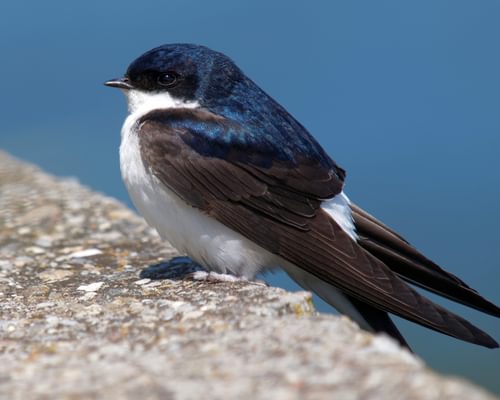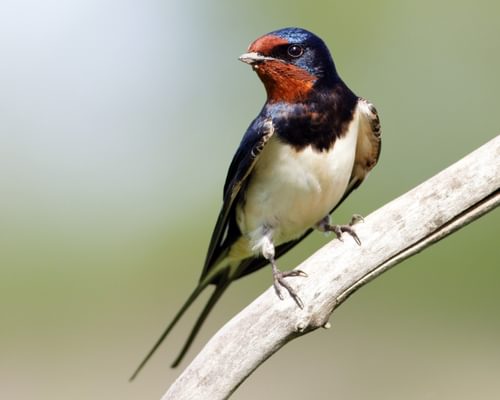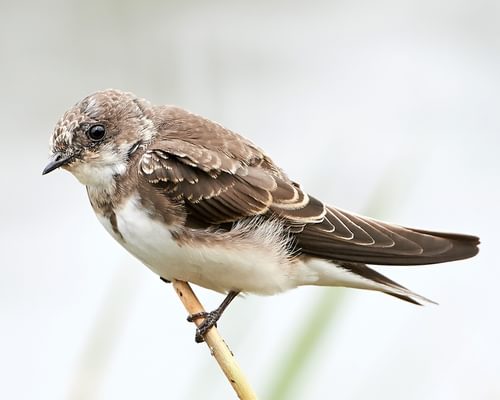Common Swift
Apus apus
Visual Identification
Appearance
The Common Swift is a sleek, sickle-shaped bird with long, narrow wings and a short, forked tail. Its plumage is predominantly sooty brown, appearing black in flight, with a small pale throat patch. The body is streamlined, with a flat head and short, wide beak.
Juveniles closely resemble adults but may have slightly paler feather edges. There is no significant difference between males and females in appearance. The swift's plumage remains consistent throughout the year, with no seasonal variations.
While challenging to observe in flight, they have miniature feet with four forward-pointing toes, which prevent them from perching on overhead wires or small branches.
Size
Length
16cm to 17cm
Wingspan
42cm to 48cm
Weight
31g to 56g
Colours
Males and females have similar plumage
Primary Colour
Black Brown
Secondary Colour
White
Beak Colour
Black
Leg Colour
Black
Habitat and Distribution
Habitats
Woodland
Garden
Wetland
Coastal
Urban
Farmland
Grassland
Desert
Tundra
Rainforest
Mountain
Savanna
Distribution
Common Swifts breed across Europe and parts of Asia, from the UK and Spain eastward to China. They prefer urban and suburban areas, nesting in buildings, but they also inhabit woodlands, cliffs, and other natural sites.
These birds are summer visitors to their breeding grounds, spending winters in sub-Saharan Africa. In the UK, they arrive in late April or early May and depart by August, making them a cherished sign of summer.
Elevation Range
Up to 3,300 meters
Climate zones
Temperate, Subtropical, Tropical
Distribution Map
This map gives you a rough idea of where you might spot a Common Swift. The coloured areas show countries where these birds have been seen.
A few things to keep in mind:
- Birds might not be everywhere in the coloured areas, for example, they may be present around the coast of that country
- Where birds live can change with seasons and available food
- This map is quite simple - it doesn't show exact locations
We're working on making our maps even better! Soon, we hope to show you:
- More detailed maps for bigger countries, including state and region
- How birds move around during different seasons
Distribution by Region
Behaviour and Ecology
Bird Attributes
This feature is in beta. We'd love your feedback to improve it!
Share your thoughtsBird Attributes Explained
Our bird attributes system rates various aspects of a bird's capabilities on a scale of 0-100, based on data from field observations, scientific studies, and expert knowledge.
Attribute Categories:
- Agility: Manoeuvrability, speed, and grace in flight or movement.
- Strength: Physical power, often correlating with size and hunting abilities.
- Adaptability: Ability to thrive in various environments or changing conditions.
- Aggressiveness: Territorial behaviour and assertiveness, particularly during breeding seasons.
- Endurance: Stamina, often seen in migration patterns or foraging behaviours.
Understanding the Ratings:
- 0-20: Very Low
- 21-40: Low
- 41-60: Average
- 61-80: High
- 81-100: Very High
Remember, these attributes are relative to other bird species and don't necessarily indicate superiority.
Hover over the icon next to each attribute for more information.
Tap the icon next to each attribute for more information.
Agility
Reflects the bird's manoeuvrability, speed, and grace in flight or movement.
The Common Swift is an aerial master, spending most of its life on the wing. Its ability to feed, drink, mate, and even sleep whilst flying demonstrates exceptional agility. With speeds over 110 km/h (around 70 mph) in level flight and adept manoeuvrability for catching insects, these birds are amongst the most agile avian species.
Strength
Indicates the bird's physical power, often correlating with size and hunting abilities.
Whilst not particularly strong in terms of raw power, Common Swifts possess remarkable stamina and efficiency in flight. Their streamlined bodies and long, narrow wings are built for sustained aerial performance rather than brute strength. However, their ability to carry nesting materials and navigate strong winds indicates moderate strength.
Adaptability
Represents the bird's ability to thrive in various environments or changing conditions.
Common Swifts show high adaptability, thriving in various habitats from urban areas to woodlands. Their ability to adjust foraging altitudes based on weather and insect availability demonstrates impressive adaptability. Moreover, their successful colonisation of man-made structures for nesting showcases their capacity to adapt to changing environments.
Aggressiveness
Measures the bird's territorial behaviour and assertiveness, particularly during breeding seasons.
Common Swifts are not typically aggressive birds. They are highly social, often seen in 'screaming parties' around buildings. While they may defend their nesting sites, they generally do not exhibit aggressive behaviour towards other species or humans. Their aerial lifestyle also minimises confrontations with potential predators.
Endurance
Reflects the bird's stamina, often seen in migration patterns or foraging behaviours.
The endurance of Common Swifts is truly remarkable. They can fly continuously for up to 10 months without landing, a feat that places them among the most enduring of all bird species. Their ability to undertake long-distance migrations from Europe to sub-Saharan Africa, coupled with their near-constant aerial lifestyle, justifies this exceptionally high endurance rating.
Diet
Common Swifts are insectivores, feeding exclusively on flying insects and airborne spiders caught on the wing. They forage at high altitudes, consuming a wide variety of prey, including flies, aphids, and small beetles.
Once caught, these insects collect in a pouch at the back of the swift’s throat, forming a pellet that can be either swallowed or regurgitated to feed chicks.
Swifts can adjust their foraging altitude based on weather conditions and insect availability.
Behaviour
Common Swifts are aerial masters, spending most of their lives on the wing. They feed, drink, mate, and even sleep while flying, only landing to nest.
These birds are highly social, often seen in screaming parties, swirling around buildings and calling to each other in excitement.
Vocalisation
The Common Swift's most recognisable call is a high-pitched, piercing scream, often described as 'sree-sree' or 'swee-ree'. These calls are frequently heard in urban areas as swifts swoop and circle in groups, especially on summer evenings.
They also produce softer, chattering sounds when at the nest.
Nesting & Breeding
Common Swifts form monogamous pairs that often reunite at the same nest site year after year. The breeding season typically begins in May upon their return from migration.
Nests are simple platforms made of feathers, plant material, and saliva, usually located in the crevices of buildings or cliff faces. Females lay 2-3 white eggs, which both parents incubate.
Incubation lasts about 20 days, with chicks fledging after 37-56 days. Young swifts exercise their wings in the nest before taking their first flight, after which they become fully independent and may not land again for two to three years.
Conservation and Status
Global Conservation Status
While listed as Least Concern globally, Common Swift populations are declining in parts of Europe, including the UK. Loss of nesting sites due to building renovations and insect decline are primary threats.
Conservation efforts focus on providing artificial nest boxes and preserving existing nesting locations.
Birdwatching Tips
- Look for sickle-shaped silhouettes high in the sky, especially on summer evenings
- Listen for their distinctive screaming calls in urban areas
- Observe their swift, agile flight patterns as they chase insects
- In the UK, watch for them around old buildings and church towers during breeding season
- Don’t confuse the swift with the swallow or house martin, which are smaller and have a white underside. Swallows and house martins can also perch, whilst swifts cannot.
Additional Information
Quick Facts
Predators
Common Swifts have few natural predators due to their aerial lifestyle. However, they may occasionally fall prey to falcons, particularly the Hobby, and other birds of prey.
Did You Know?
- Common Swifts can fly continuously for up to 10 months without landing.
- They are among the fastest birds in level flight, reaching speeds of over 110 km/h (around 70 mph).
- They can fly an average of 570 km per day, with the fastest swifts covering up to 832 km in a single day.
- Swifts are unable to take off from a flat surface due to their extremely short legs.
FAQs
What is a group of Swifts called?
Known collective nouns for a group of Swifts are as follows:
- a box of swifts
- a drift of swifts
- a flock of swifts
- a screaming frenzy of swifts
- a swoop of swifts
Similar Birds
References
- 1 2
website: BirdLife International. 2016. Apus apus. The IUCN Red List of Threatened Species 2016: e.T22686800A86111691.
View source - 3
report, 2015: EBCC
- 4
website, 2010: Fransson et al., EURING list of longevity records for European birds
View source
Share Your Feedback
We value your opinion! Let us know what you think about this bird page.


